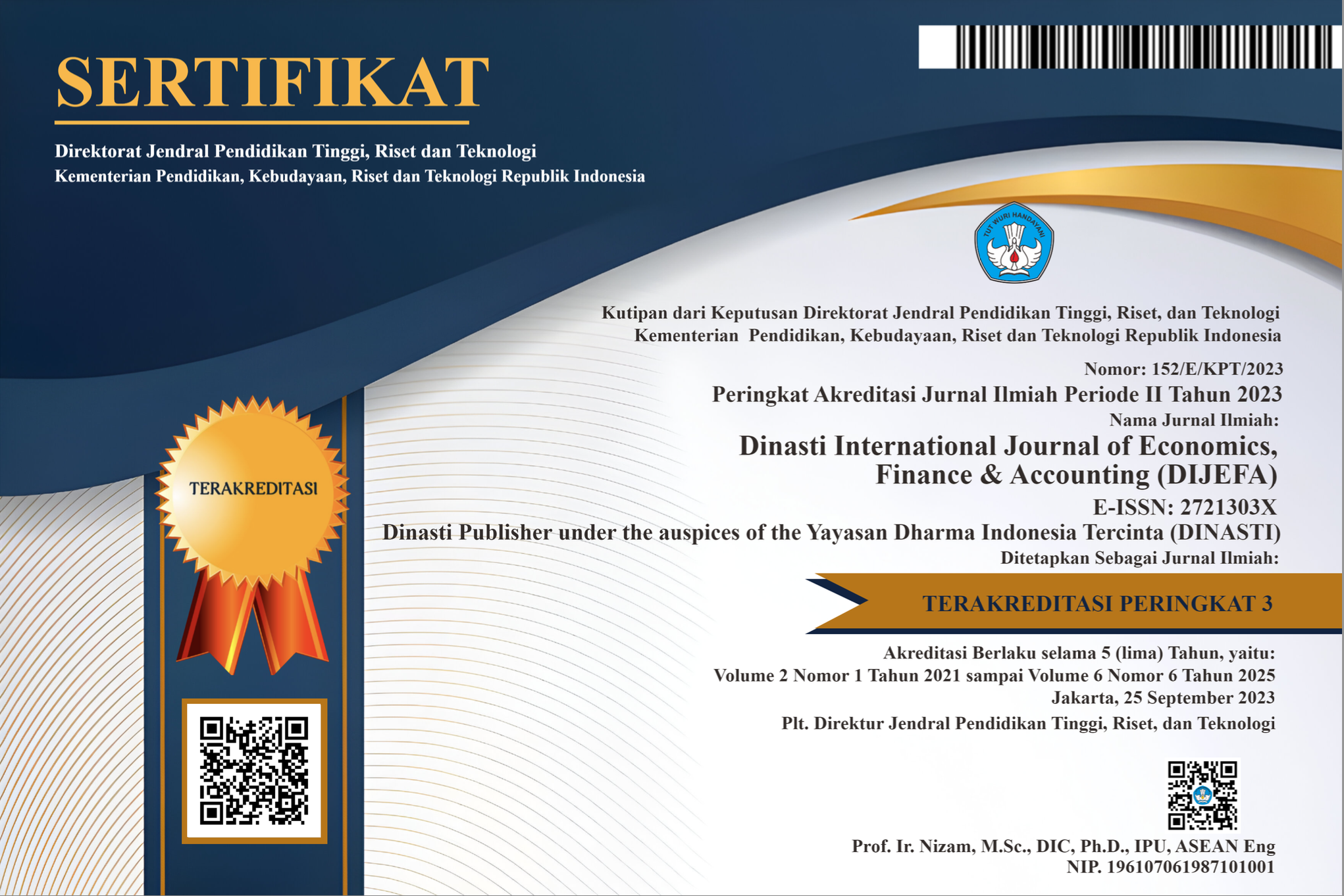Analysis Of Operational Risk Using Loss Distribution Approach : A Study Of Epc Business
DOI:
https://doi.org/10.38035/dijefa.v5i5.3110Keywords:
Operational Risk, EPC Companies, Loss Distribution Approach Method, Operational Value At Risk, Risk MitigationAbstract
This abstract describes a comprehensive analysis of operational risks in engineering, procurement, and construction (EPC) business by using calculation of loss distribution approach methods. This research involves an examination of historical operational losses data spanning from January 2019 to December 2022 to calculate the Operational Value at Risk at different percentiles. The OpVar, a key metric in this study, is determined to be Rp17,68Billion at a 95% percentile and Rp41,4Billion at a 99% percentile. These figures represent the estimated financial loss that EPC company may face due to operational risk with a higher percentile may indicate more precise. These results were declared valid through backtesting. From these points, the research emphasizes that the signifance of understanding and learning from historical data, will enable EPC companies to understand potential risks and manage risks through risk mitigation strategies in the complexity of EPC business environment.
References
Adafin, J., Rotimi, J. O. B., & Wilkinson, S. (2016). Risk impact assessments in project budget development: architects’ perspectives. Architectural Engineering and Design Management, 12(3), 189–204. https://doi.org/10.1080/17452007.2016.1152228
Amiri, O. , R., M., A. A., & Khazaeni, G. (2021). Multi-criteria decision-making model for EPC contractor prequalification: a hybrid approach. International Journal of Building Pathology and Adaptation.
Basel Committee on Banking Supervision. (2021). Revisions to the Principles for the Sound Management of Operational Risk. Bank for International Settlements. www.bis.org
Carrillo, P. (2005). Lessons learned practices in the engineering, procurement and construction sector. Engineering, Construction and Architectural Management, 12(3), 236–250. https://doi.org/10.1108/09699980510600107
Davies, J., Finlay, M., McLenaghen, T., & Wilson, D. (2006). Key Risk Indicators – Their Role in Operational Risk Management and Measurement . Risk Business International Limited .
El-Reedy, M. A. (2011). Construction Management of Industrial Projects. Scrivener Publishing.
GARP. (2023). Foundation of Risk Management 2023: Vol. Exam Part I. Pearson Education, Inc.
Hull, J. C. (2023). Risk management and financial institutions (6th ed.). John Wiley & Sons, Inc.
Ishii, N., Takano, Y., & Muraki, M. (2014). An order acceptance strategy under limited engineering man-hours for cost estimation in Engineering-Procurement-Construction projects. International Journal of Project Management, 32(3), 519–528. https://doi.org/10.1016/j.ijproman.2013.07.009
Jorion, P. (2007). Value at Risk. The New Benchmark for Managing Financial Risk (3rd ed.). McGraw-Hill.
Lee, P., Lam, P. T. I., & Lee, W. L. (2015). Risks in Energy Performance Contracting (EPC) projects. Energy and Buildings, 92, 116–127. https://doi.org/10.1016/j.enbuild.2015.01.054
Liu, B., Huo, T., Meng, J., Gong, J., Shen, Q., & Sun, T. (2016). Identification of Key Contractor Characteristic Factors That Affect Project Success under Different Project Delivery Systems: Empirical Analysis Based on a Group of Data from China. Journal of Management in Engineering, 32(1). https://doi.org/10.1061/(asce)me.1943-5479.0000388
Mathew, P., Kromer, J. S., Sezgen, O., & Meyers, S. (2005). Actuarial pricing of energy efficiency projects: Lessons foul and fair. Energy Policy, 33(10), 1319–1328. https://doi.org/10.1016/j.enpol.2003.12.008
Micheli, G. J. L., & Cagno, E. (2016). The role of procurement in performance deviation recovery in large EPC projects. International Journal of Engineering Business Management, 8, 1–17. https://doi.org/10.1177/1847979016675302
Molak, V. (2020). Fundamentals of Risk Analysis and Risk Management (1st ed.). CRC Press.
Mukilan, K., Rameshbabu, C., & Velumani, P. (2020). A modified particle swarm optimization for risk assessment and claim management in engineering procurement construction projects. Materials Today: Proceedings, 42, 786–794. https://doi.org/10.1016/j.matpr.2020.11.315
Nguyen, H. T., & Hadikusumo, B. H. W. (2018). Human resource related factors and engineering, procurement, and construction (EPC) project success. Journal of Financial Management of Property and Construction, 23(1), 24–39. https://doi.org/10.1108/JFMPC-05-2016-0023
Yau, N.-J., & Yang, J.-B. (2012). Factors Causing Design Schedule Delays in Turnkey Projects in Taiwan Terminology and Literature Review. Project Management Journal. https://doi.org/10.1002/pmj
Osipova, E. (2015). Establishing Cooperative Relationships and Joint Risk Management in Construction Projects: Agency Theory Perspective. Journal of Management in Engineering, 31(6). https://doi.org/10.1061/(asce)me.1943-5479.0000346
Pícha, J., Tomek, A., & Löwitt, H. (2015). Application of EPC Contracts in International Power Projects. Procedia Engineering, 123, 397–404. https://doi.org/10.1016/j.proeng.2015.10.061
PMBOK (Guide). (2021). The Standard for Project Management and a Guide to the Project Management of Body Knowledge (7th ed.). Project Management Institute.
Prabantarikso, Dr. R. M., Fahmy, S. E. , M. M. E., Abidin Ph.D, Z., & Abdulrachman, Drs. Y. (2022). Konsep Dan Penerapan Manajemen Risiko Operasional: RCSA-KRI-LED. Deepublish.
Song, Y., & Hao, S. (2020). ISM Based Method for Risk Management of International EPC Projects. IOP Conference Series: Earth and Environmental Science, 455(1). https://doi.org/10.1088/1755-1315/455/1/012208
Taroun, A. (2014). Towards a better modelling and assessment of construction risk: Insights from a literature review. International Journal of Project Management, 32(1), 101–115. https://doi.org/10.1016/j.ijproman.2013.03.004
Wu, Y. (2021). Summary of Research on Contract Risk Management of EPC General Contracting Project—Based on VOSviewer Knowledge Graph Analysis. Proceedings of the 25th International Symposium on Advancement of Construction Management and Real Estate, (CRIOCM 2020).
Downloads
Published
How to Cite
Issue
Section
License
Copyright (c) 2024 Lydia Tiara, Ruslan Prijadi

This work is licensed under a Creative Commons Attribution 4.0 International License.
Authors who publish their manuscripts in this journal agree to the following conditions:
- The copyright on each article belongs to the author(s).
- The author acknowledges that the Dinasti International Journal of Economics, Finance & Accounting (DIJEFA) has the right to be the first to publish with a Creative Commons Attribution 4.0 International license (Attribution 4.0 International (CC BY 4.0).
- Authors can submit articles separately, arrange for the non-exclusive distribution of manuscripts that have been published in this journal into other versions (e.g., sent to the author's institutional repository, publication into books, etc.), by acknowledging that the manuscript has been published for the first time in the Dinasti International Journal of Economics, Finance & Accounting (DIJEFA).


























































